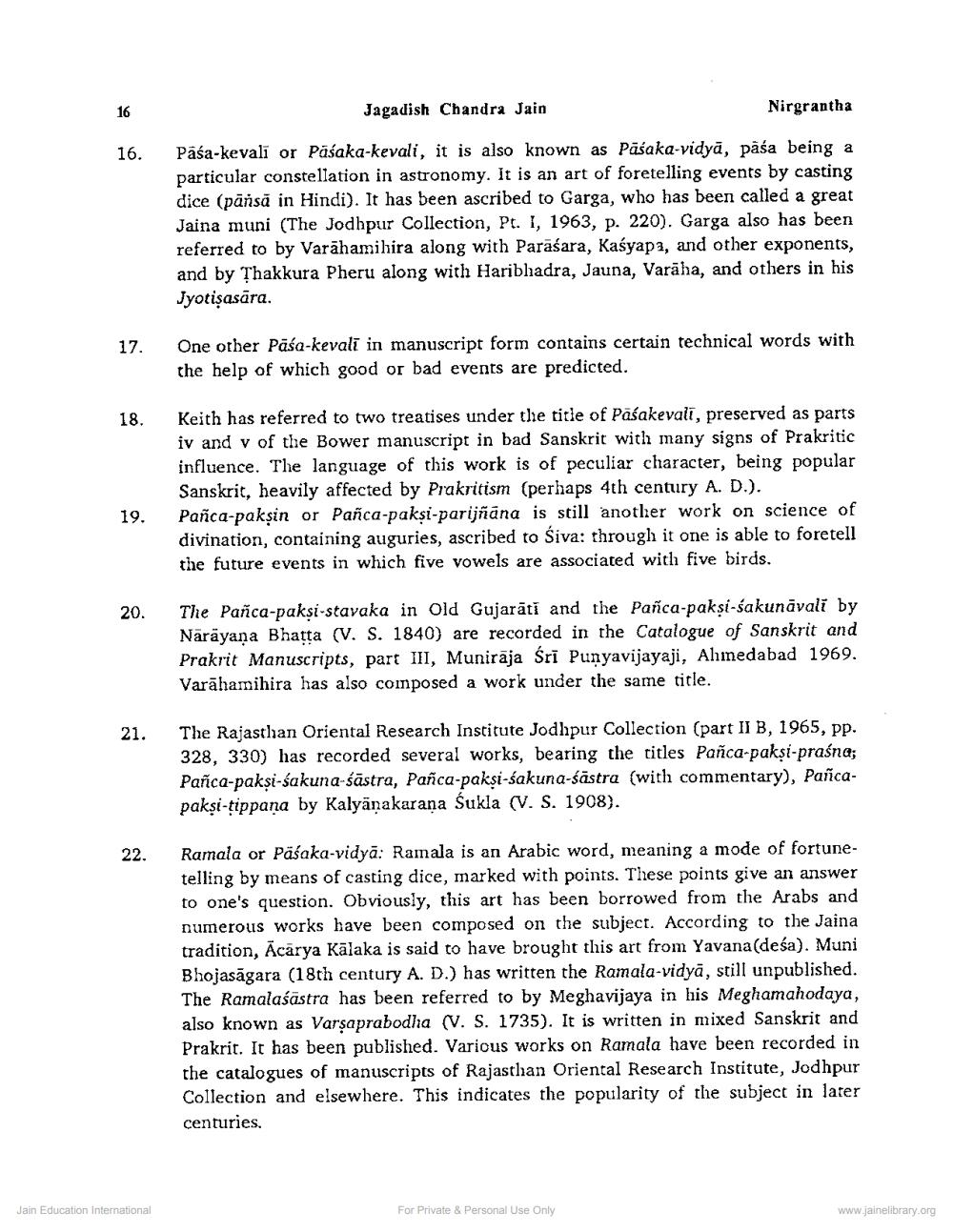Book Title: Some Prakrit Works on Non Religious Literature Author(s): Jagdishchandra Jain Publisher: Z_Nirgrantha_1_022701.pdf and Nirgrantha_2_022702.pdf and Nirgrantha_3_022703.pdf View full book textPage 6
________________ Jagadish Chandra Jain Nirgrantha 16. Pāśa-kevali or Pāśaka-kevali, it is also known as Pāšaka-vidyā, pāśa being a particular constellation in astronomy. It is an art of foretelling events by casting dice (pānsă in Hindi). It has been ascribed to Garga, who has been called a great Jaina muni (The Jodhpur Collection, Pt. I, 1963, p. 220). Garga also has been referred to by Varāhamihira along with Parāśara, Kaśyap2, and other exponents, and by Thakkura Pheru along with Haribhadra, Jauna, Varāha, and others in his Jyotişasara. 17. One other Pāśa-kevali in manuscript form contains certain technical words with the help of which good or bad events are predicted. 18. Keith has referred to two treatises under the title of Pašakevali, preserved as parts iv and v of the Bower manuscript in bad Sanskrit with many signs of Prakritic influence. The language of this work is of peculiar character, being popular Sanskrit, heavily affected by Prakritism (perhaps 4th century A. D.). Pañca-paksin or Panca-paksi-parijñāna is still another work on science of divination, containing auguries, ascribed to Śiva: through it one is able to foretell the future events in which five vowels are associated with five birds. 19. 20. The Pañca-paksi-stavaka in Old Gujarati and the Panca-paksi-sakunāvali by Narayana Bhatta (V. S. 1840) are recorded in the Catalogue of Sanskrit and Prakrit Manuscripts, part III, Muniraja Śrī Punyavijayaji, Ahmedabad 1969. Varāhamihira has also coinposed a work under the same title. 21. The Rajasthan Oriental Research Institute Jodhpur Collection (part II B, 1965, pp. 328, 330) has recorded several works, bearing the titles Pañca-paksi-praśna; Pañca-paksi-sakuna-śāstra, Pañca-paksi-sakuna-śāstra (with commentary), Pañcapakşi-tippana by Kalyānakarana śukla (V. S. 1908). 22. Ramala or Pāśaka-vidyā: Ramala is an Arabic word, meaning a mode of fortunetelling by means of casting dice, marked with points. These points give an answer to one's question. Obviously, this art has been borrowed from the Arabs and numerous works have been composed on the subject. According to the Jaina tradition, Ācārya Kālaka is said to have brought this art from Yavana(deśa). Muni Bhojasāgara (18th century A. D.) has written the Ramala-vidyā, still unpublished. The Ramalaśāstra has been referred to by Meghavijaya in his Meghamahodaya, also known as Varşaprabodha (V. S. 1735). It is written in mixed Sanskrit and Prakrit. It has been published. Various works on Ramala have been recorded in the catalogues of manuscripts of Rajasthan Oriental Research Institute, Jodhpur Collection and elsewhere. This indicates the popularity of the subject in later centuries. Jain Education International For Private & Personal Use Only www.jainelibrary.orgPage Navigation
1 ... 4 5 6 7 8 9 10
